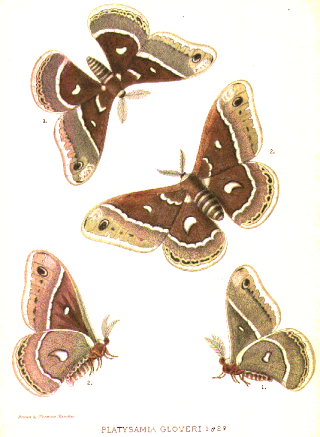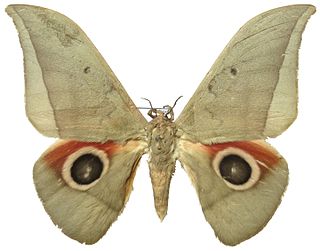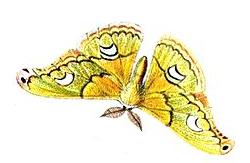
Hyalophora cecropia, the cecropia moth, is North America's largest native moth. It is a member of the family Saturniidae, or giant silk moths. Females have been documented with a wingspan of five to seven inches or more. These moths can be found all across North America as far west as Washington and north into the majority of Canadian provinces. Cecropia moth larvae are most commonly found on maple trees, but they have also been found on cherry and birch trees among many others. The species was first described by Carl Linnaeus in his 1758 10th edition of Systema Naturae.

Saturnia is a genus of large silkmoths in the family Saturniidae, which the German biologist Franz von Paula Schrank first described in 1802. Its members are commonly named emperor moths, though this is also used for various close relatives in subfamily Saturniinae. Most species are Palearctic, but three, commonly called "saturnia moths", inhabit the chaparral of California: S. mendocino, S. walterorum, and S. albofasciata.

The Saturniinae or saturniines are a subfamily of the family Saturniidae, also known as giant silkmoths. They are commonly known as emperor moths or wild silk moths. They are easily spotted by the eyespots on the upper surface of their wings. Some exhibit realistic eye-like markings, whilst others have adapted the eyespots to form crescent moon or angular shapes or have lost their wing scales to create transparent windows. They are medium to very large moths, with adult wingspans ranging from 7.5 to 15 cm, in some cases even more. They consist of some of the largest sized Lepidoptera, such as the luna moth, atlas moth, and many more. The Saturniinae is an important source of wild silk and human food in many different cultures.

Eupackardia is a monotypic moth genus in the family Saturniidae erected by Theodore Dru Alison Cockerell in 1912. Its only species, Eupackardia calleta, the calleta silkmoth, was described by John O. Westwood in 1853. It is found in Mexico, Guatemala, as well as in the states such as; Arizona, New Mexico, and Texas.

Hyalophora gloveri, or Glover's silkmoth, is a moth of the family Saturniidae. The species was first described by Ferdinand Heinrich Hermann Strecker in 1872. It is found in the Rocky Mountain states, the western parts of the northern Great Plains, and the Canadian prairie provinces, north-west to at least central Alberta. It is also found in northern Mexico.

Hyalophora euryalus, the ceanothus silkmoth, is a moth of the family Saturniidae. It is found in the dry intermontane valleys and interior of British Columbia, Canada, south to Baja California in Mexico. The species was first described by Jean Baptiste Boisduval in 1855.

Arsenura is a genus of moths in the family Saturniidae. The genus was erected by James Duncan and John O. Westwood in 1841.

Hyalophora columbia, the Columbia silkmoth or larch silkmoth, is a moth of the family Saturniidae. In the east it is found from Quebec and Ontario to Michigan, northern Wisconsin, and south-eastern Manitoba. In the west it is found from Alberta and Montana south through the Rocky Mountains to south-western Texas and into central Mexico. The species was first described by Sidney Irving Smith in 1865.

Copiopteryx is a genus of moths in the family Saturniidae first described by James Duncan and John O. Westwood in 1841.
Automerina is a genus of moths in the family Saturniidae first described by Charles Duncan Michener in 1949.

Leucanella is a genus of moths in the family Saturniidae first described by Claude Lemaire in 1969.

Lobobunaea is a genus of moths in the family Saturniidae first described by Packard in 1901.

Copaxa lavendera is a species of moth in the family Saturniidae first described by John O. Westwood in 1854. It is found from Mexico to Honduras. It has been spotted in the Netherlands on multiple occasions, where it was imported on plants.

Copaxa sapatoza is a species of moth in the family Saturniidae first described by John O. Westwood in 1854 as Saturnia sapatoza. It is found in the north-east of the Andean Cordillera in Colombia at high elevations.

Leucanella janeira is a species of moth in the family Saturniidae first described by John O. Westwood in 1854. It is found in South America, including Brazil.

Rothschildia orizaba, the Orizaba silkmoth, is a moth in the family Saturniidae. The species was first described by John O. Westwood in 1854. It is found in Mexico, Central and South America.

Actias chapae or colloquially known as the 'celestial moon moth' is a moth in the family Saturniidae. It is found in Vietnam and China and potentially other countries in the region; it is a montane species recorded from 1500m and higher. It appears to be an exclusive pine feeder and has been raised on many different species of Pinus in captivity.

Actias keralana is a species of moth of the family Saturniidae described by Wolfgang A. Nässig, Stefan Naumann and Alessandro Giusti in 2020. It is native to southern India.














